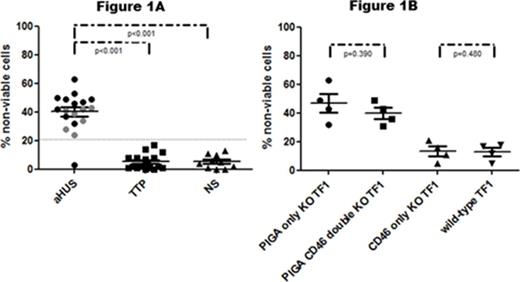Abstract

Introduction: Atypical hemolytic uremic syndrome (aHUS) is a disease of excessive alternative pathway of complement (APC) activation that can be treated with eculizumab. Clinicians have been hesitant to administer eculizumab because of the lack of a diagnostic assay for aHUS and the expense of the drug. Mutations in genes that regulate the APC (factor H/CFH, I/CFI, CD46, etc.) underlie up to 50% of aHUS patients, but the clinical relevance of these mutations is often unclear. We developed the modified Ham test to distinguish aHUS from thrombotic thrombocytopenic purpura (TTP). This functional assay measures cell viability (WST-1) of a PIGA mutant cell line following exposure to patient serum. The cells are more sensitive to APC killing because complement regulators CD55 and CD59 are absent from the cell surface. CD46 is a transmembrane APC regulator that remains on the surface of the PIGA- null TF1 cells. Here, we show that the modified Ham test predicts response to eculizumab and can be adapted to assess the contribution of APC mutations to clinical phenotype.
Method: We studied adult patients with thrombotic microangiopathies (TMA) who presented to our hospital from July 2014 through June 2015 and two patients from outside institutions. aHUS was defined by the presence of a TMA with platelet count <100 x 109/L, serum creatinine >2.25 mg/dL, and ADAMTS13 activity >10%. TTP was defined as TMA in association with an ADAMTS13 ≤ 10%. Response to eculizumab was defined as TMA event-free status for at least 12 weeks and normalization of hematologic values. The modified Ham test was performed utilizing PIGA-null myeloid TF1 (PIGA only knockout/KO) as previously described. We additionally knocked-out CD46 / membrane cofactor protein (MCP) gene in the PIGA-null TF-1 cell line (PIGA/CD46 double KO), and wild-type TF1 cells (CD46 only KO) using CRISPR/Cas9 technology.
Results: The modified Ham test was performed using PIGA-null TF1 reagent cells with 37 serum samples from 29 patients with TMAs. 13 patients were diagnosed with aHUS, 15 with TTP, and 1 with TMA of unknown etiology. APC-mediated cell killing was significantly increased in patients with aHUS compared to TTP (Figure 1A, grey shapes symbolize patients on eculizumab). In the ROC analysis, the cut-off value of 20.5% killing suggests an aHUS diagnosis with 100% specificity and 94.1% sensitivity. One patient presented with a TMA of unknown etiology (normal ADAMTS13 levels, and did not satisfy criteria for aHUS due to a creatinine of <1.3; no known complement-related mutations or autoantibodies were detected). The patient showed no increased killing with the modified Ham test and had a transient response to plasma exchange and eculizumab but relapsed after 8 weeks of eculizumab treatment.
12 aHUS patients received eculizumab and all responded to treatment. Eculizumab was discontinued in 6 patients after a median 11 doses (range 5-37) and all remain in remission for 8 months (range 4-15). The modified Ham test was positive in all aHUS patients that responded to eculizumab (positive predictive value 100%) and negative in 1 responder with a heterozygous variant of unknown significance in DGKE. Among 12 patients with aHUS, 7 patients had mutations in genes previously associated with aHUS (3 CFH, 1 DGKE, 1 CFH and CD46, 1 CFH and ADAMTS13, and 1 CFH and thrombomodulin). Six of those patients had additional heterozygous deletions in the CFHR3-CFHR1 gene region.
To study the impact of CD46 insufficiency on complement regulation we exposed PIGA/CD46 double KO TF1, and CD46 only KO lines to aHUS serum and measured cell viability in the modified Ham test. The CD46 KO line was no more susceptible to killing than wild-type TF1 cells and the PIGA/CD46 double KO cells were no more sensitive to killing than the PIGAonly KO cells, suggesting that CD46 is a weak complement regulator compared to the combination of CD55 and CD59 (Figure 1B).
Conclusions: The modified Ham test reliably distinguishes most forms of aHUS from TTP and predicts response to eculizumab. Mutations in CD46 do not impact susceptibility to APC killing in the modified Ham test. The modified Ham test may be adapted to inform investigators and clinicians on the correlation between genotype and phenotype.
Moliterno:Incyte: Membership on an entity's Board of Directors or advisory committees. Sperati:Alexion Pharmaceuticals: Other: Principal investigator for the international aHUS registry. Brodsky:Alexion Pharmaceuticals: Membership on an entity's Board of Directors or advisory committees.
Author notes
Asterisk with author names denotes non-ASH members.

This icon denotes a clinically relevant abstract


This feature is available to Subscribers Only
Sign In or Create an Account Close Modal